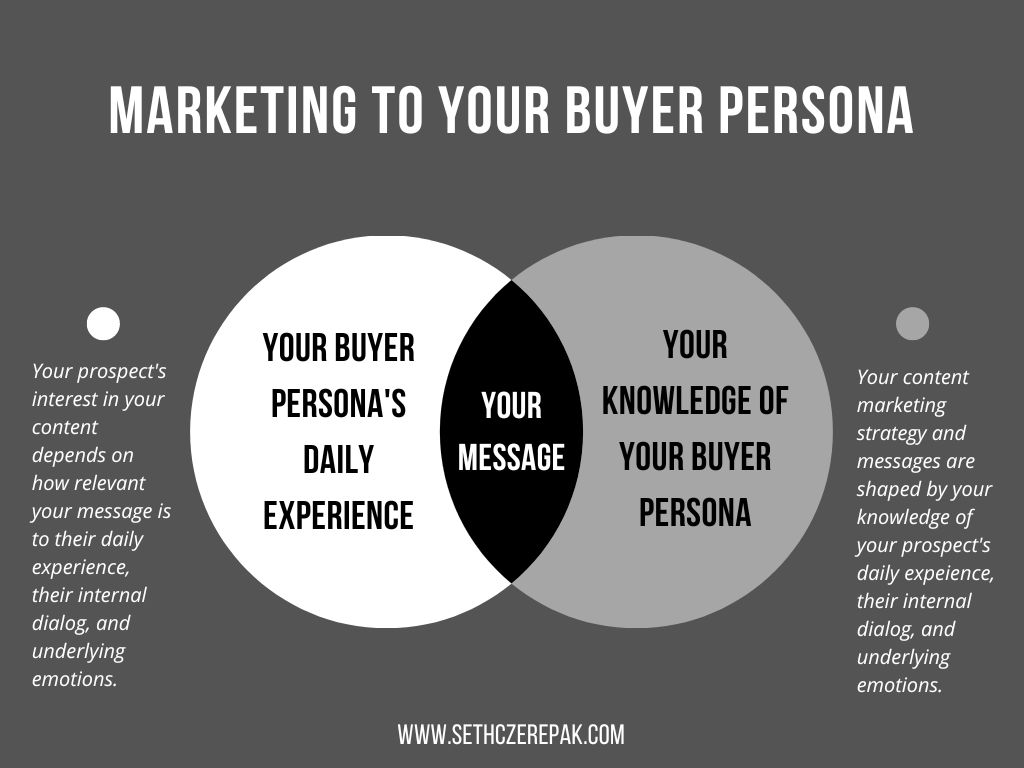How to Create a Buyer Persona
Buyer Persona: a semi-fictitious profile of your ideal customer based on data and research of one or all of the following… 1) your existing customers, 2) your competitors’ audience(s), 3) the demographics of your niche or industry.
Topics Covered in This Article
How to Create a Buyer Persona
Any successful Content Marketing Strategy starts with knowing How to Create a Buyer Persona. In my experience, content marketing efforts based on a well-defined buyer persona are much more likely to succeed.
This is why the second step of your content marketing strategy is to thoroughly define your buyer persona. The better defined your buyer’s persona, the more focus, clarity, and momentum you’ll build as you move through the other steps of your content marketing strategy.

This article gives you a complete B2C Buyer Persona Template and B2B Buyer Persona Template, including detailed explanations and examples for each individual buyer persona trait. You’ll also get a step-by-step strategy for using your buyer persona template to write interesting and compelling content. Here are some measurable benefits you can expect from using the templates and formulas in this article.
Benefits of a Buyer Persona
Research from CMI (cited below) tells us that most B2C marketers create content for an average of four distinct audiences, with 95% having more than one audience, and 54% having four or more. It also reveals that B2B content marketers create content for an average of three audiences; with 95% having more than one, and 45% having four or more.
These companies understand a simple fact that few digital marketers (besides myself and a handful of direct response copywriters) were even thinking about back in 2010. They understand that personalized, buyer persona-based marketing content is more engaging and profitable than content created without a buyer persona. Here are some of the data points taken from the research mentioned in the previous paragraph:
Source: boardview.io blog on buyer’s persona statistics.
These are the measurable benefits of knowing how to create a buyer persona and use it in your content marketing. I share these to prove that the detailed steps laid out in this article are well worth your time and energy. Many small businesses, solo entrepreneurs, and startups think they can get away with generic audience descriptions like these:
- “Our target audience is anyone who needs our service.”
- “Our target audience is anyone who wants to ___.”
- “Our target audience is anyone with a ___ problem.”
A good content marketing agency will tell you that your buyer persona needs to be more specific and detailed than this. This requires a lot of patience and delayed gratification, as most people want to jump right into their content creation plan.
However, the above statistics prove that if you start with our buyer persona, you’ll get more leads, higher quality prospects, higher sales revenue, and shorter sales cycles. That said, let me introduce a B2C Buyer Persona Template and a B2B Buyer Persona Template with examples of their buyer persona traits. I’ll start with the B2C Template. You can skip to the B2B Template by clicking here.
How to Create a Buyer Persona: B2C Template
Our B2C Buyer Persona Template includes six individual traits:
Buyer Persona Trait #1: Generation
EXAMPLE: Millennials born between 1985 and 1995.
Your first job is to define your buyer persona according to their generation and corresponding age range.
If you plan to market to multiple generations, use each of those generations to create a separate buyer persona, like this:
- PERSONA #1: Millennials born between 1985 and 1995.
- PERSONA #2: Generation X’ers born between 1970 and 1985.
This is an important distinction because it lets you market to each generation according to their preferences and interests. For examples, Baby Boomers are drastically different than Millennials in their buying habits and their ideology. The same is true (although less drastically) when comparing Generation X to Generation Z.
So, splitting up your buyer personas by their generation will make it much easier for you to match your content marketing messages to their values and vernacular. It will also help you define some of your other B2C buyer persona traits.
Buyer Persona Trait #2: Social Status
EXAMPLE: Single with no children and living with a fiance or long-term romantic partner.
Your second job is to define your buyer’s persona according to their relationship status and living arrangements. This is not as simple as it was in the late 20th Century. Today, we have more mixed families and more adults living in multi-family households or with their parents or relatives. This is why it’s important to define your buyer’s persona beyond their marital status.
Defining your audience’s relationship status and living arrangements will help you determine their interests, shopping habits, and purchasing power. If you’re unclear on how to define this trait at first, just start with your best guess. The good thing about working from a buyer persona is that you can refine it as you learn more about your audience.
Buyer Persona Trait #3: Economic Status
EXAMPLE: $30k to $45k yearly income – $2,000 to $2,500 monthly expenses – $10k in debt – $10k net worth.
There’s more to this step than just defining your audience’s average yearly income. Yearly income doesn’t tell you enough about your audience’s purchasing power or their buying habits. Other factors to consider are their monthly expenses, debt (not including their mortgage), net worth, and whether they’re likely to be renting, paying a mortgage, living with relatives, or living in a paid-off home.
Buyer Persona Trait #4: Gender Group
EXAMPLE: Traditionally masculine men.
This is a controversial topic, but essential for marketing to modern consumers. If you prefer to think of this in terms of right and left brain traits, that’s fine. The idea is to go beyond defining your buyer’s persona strictly according to the assumed traits of their biological sex.
Thanks to the research of Psychologists like Steven Pinker, we know that humans aren’t simply blank slates. We have intrinsic biological traits, and no amount of cultural influence can blot that out. However, some men are more traditionally masculine than others, and some women are more traditionally feminine than others.
Sure, you can try to market to a man in skinny jeans and a man bun the same way you market to a man who literally splits his own firewood. Likewise, you can try to market to a conservative housewife the same way you market to the single feminist entrepreneur owner who works 14-hour days building her own personal empire.
But, you’ll get a clearer picture of your audience by defining their biological sex as either male or female and their gender in terms of masculine or feminine. In my experience, the more clarity you have on this point, the easier it will be to customize your content to match your buyer persona(s).
Buyer Persona Trait #5: Education Level
EXAMPLE: Four-year college degree in science or business.
This is probably the most important factor for content marketers to define. It determines where your readability scores should be and how simple, or sophisticated, your content should be in terms of vocabulary and concept development.
As someone who has decades of experience writing sales scripts and advertising copy, I can tell you that the marketing industry is full of overgeneralized assumptions about this. The common dogma is that your readability scores should be between the 4th and 7th-grade levels.
This makes sense for certain education levels. For others, it’s a quick way to make your content look low-budget and unsophisticated. Your readability scores, lexicon, and content should depend on how well-educated your audience is.
Buyer Persona Trait #6: Lifestyle
EXAMPLE: American-born, libertarian, Christian, outdoorsman, history buff.
This is absolutely the most important trait of your buyer’s persona. It’s also a trait many marketers shy away from defining for fear of “alienating” people who don’t fit the profile. This is one of the most mistaken assumptions people make about content marketing.

However, the clearer you are about your audience’s cultural background, ideology, hobbies, and interests, the more authentic and compelling your content will be. It’s easy to spot an “outsider” who is trying to relate with a group of people they don’t understand. The outsider’s lack of understanding shows up in their speech and makes them sound awkward and inauthentic.
Modern consumers have a wide variety of choices about where to get their content. Why should they read articles or watch videos published by a company that can’t relate to them in an authentic way? This is especially important today since more people are choosing to do business with companies that share their beliefs and values. This is why it’s so important to define your audience’s cultural background, ideology, hobbies, and interests.
This concludes our breakdown of how to create a buyer persona for a B2C business.
How to Create a Buyer Persona: B2B Template
Our B2B Buyer Persona Template includes twelve individual traits:
Notice that these B2B buyer persona traits define two things. First, they define the type of company we’re marketing to. This is the purpose of traits 1-6. Secondly, they define the buyer persona traits of the Decision-Maker (DM) at our target company. The Decision-Maker is the person who will be make the ultimate choice about whether (and when) to purchase the product or service you’re promoting. This is the purpose of traits 7-12.
This is the one thing that B2B and B2C content marketing have in common. Our reader is a buyer, and a buyer is a person, not a company.
True, the business model of our target company has a big influence on how our Decision-Maker gathers information and makes their buying decision. That’s why we start by defining the four company-related traits.

From there, our goal is to define the traits of our Decision-Maker so we can create marketing content that is interesting and relevant to them and their decision marking process. Again, our reader is the Decision-Maker, and that Decision-Maker is a person. The more we understand the reading habits, interests, and dynamics (personal or company culture related) that drive their buying decisions, the more compelling our marketing content will be.
Buyer Persona Trait #1: Industry
EXAMPLE: Hemp-Based CBD product manufacturers.
This B2B buyer persona trait is self-explanatory. Even companies who don’t know how to create a buyer persona usually have this trait defined. Marketing to a few specific industries allows you to position your company as specialists and (when done right) charge premium fees for your B2B product or service. If you plan to market to multiple industries, use each industry to create a separate buyer persona, like this…
- PERSONA #1: Hemp-Based CBD product manufacturers.
- PERSONA #2: Organic food and beverage manufacturers.
Splitting up your B2B buyer personas like this makes it easier to match your content marketing messages to the nuances and terminology of their industry. It will also help you define some of your other B2B buyer persona traits.
Buyer Persona Trait #2: Business Model
EXAMPLE: Sells private label product subscriptions sold and at trade shows by their outside sales team and to website leads by their inside (phone) sales team.
A business model is a description of how a business generates income (including products or services and how they’re delivered and paid for by the customer), technology infrastructure, personnel, and operational processes and policies. Your definition of this B2B buyer persona trait can be simple (as in the example above), or detailed.
For example, a detailed description of your target company’s business model might include everything from their marketing channels, to their funding sources (loans, grants, etc), personnel structure (in-house employees vs contractors, etc), operational infrastructure (virtual or physical), and even their own target audiences and marketing channels.
The more you understand the business model of your buyer persona, the greater variety of options you’ll have for creating relevant content. For example, let’s assume the industry for your B2B buyer persona is “Organic food and beverage manufacturers” (as in the example above). These are the types of companies you’re trying to reach with your marketing content.
If your description of their business model is consistent with the products or services they sell, your content should only be about those types of products or services. You might also be able to create some general content about their sales or marketing process.
However, if your definition of their business model includes funding sources, personnel structure, operational infrastructure, and their own target audience, you can expand your content marketing strategy to include those topics.
Buyer Persona Trait #3: Company Size
EXAMPLE: 10 to 20 employees, 3 to 4 C-Suite executives, 5 to 10 contractors.
This B2B buyer persona trait is more relevant for some types of products or services than for others. For example, if you’re selling project management software, payroll software, or employee recruiting services, the size of your target company is important. If you’re selling web design services, freelance writing services, or advertising space, the size of your target company might not matter at all.

If you run a marketing agency that offers managed marketing services, your target company might routinely hire teams of contractors to assist with marketing projects.
If you’re a business communications consultant who specializes in working with C-Suite (CEOs, COO, CFOs, etc), your target company might have a certain number of people working in the C-Suite.
This is why I suggest that you define this B2B buyer persona trait according to what is most relevant to the type of product or service you’re offering. Doing this will give you insight into what might cause the Decision-Makers in your target company to seek out your content. For instance, a small business with two people in the C-Suite will have different challenges than a company with a half dozen people in the C-Suite.
The more clarity you have on these things, the better job you can do at researching the challenges most commonly faced by companies matching your buyer persona. If your content demonstrates that you understand these problems and how to solve them, you will be much more effective in generating quality leads and sales.
Buyer Persona Trait #4: Company Financials
EXAMPLE: $5 to $10 million yearly income – $50k to $100k monthly expenses – $1 million in debt – $1 million net worth.
This B2B buyer persona trait helps you clarify a few important things. First, it helps you target the companies that can afford your product or service. For example, if you’re a business consultant who hopes to charge $200 an hour for your services, you’d be a fool to target businesses making less than $1 million a year.
Even if this company has the money to hire you, they probably have dozens of more urgent expenses to worry about. Likewise, if you run a marketing or PR agency and hope to routinely close $20k contracts for your services, you’ll want to target companies making at least $5 million a year.
Secondly, this buyer persona trait helps you position yourself more efficiently against competitors. For example, if you’re selling business consulting services to smaller businesses ($1 million yearly income), your competitors will probably be other solo consultants.
However, if you decide to target medium-sized companies ($5 to $10 million yearly income), your competitors will probably be larger consulting firms. This is a significant difference that will require you to position yourself differently against your competitors.

For example, if you’re competing against other solo consultants, you might position yourself as a specialist in your target company’s industry or business model. But, if you’re competing against consulting firms, you might focus on the shortcomings of larger firms, and the benefits of working with a single specialist.
Finally, this B2B buyer persona trait gives you insight into which challenges might cause the Decision-Makers at your target company to seek out your content. For instance, a small business with a low monthly income, low net worth, and a lot of debt will have different challenges than a business with a high monthly income, high net worth, and no debt.
The more clarity you have on the financial status of your target company, the better job you can do at researching the challenges most commonly faced by companies matching your buyer persona. If your content demonstrates that you understand these problems and how to solve them, you will be much more effective in generating quality leads and sales.
If you’re targeting medium-sized companies, your Decision-Maker will likely be someone in the C-Suite. If you’re targeting large companies, your Decision-Maker will either be someone in the C-Suite, or a purchasing manager. Whoever they are, your Decision-Maker is the person whom you want reading your marketing content.
The better informed your Decision-Maker is about your product or service and its benefits, the more likely they’ll be to buy your product or hire you, and at premium prices. This is especially true when your Decision-Maker discovers your marketing content early in the buyer’s journey.
If your marketing content puts you on your Decision-Maker’s radar early in the buyer’s journey, you’ll have an advantage over any competitors who show up later in the cycle. I unpack this topic in more detail in our Buyer’s Journey vs Customer Journey article.
Buyer Persona Trait #6: Decision Process
EXAMPLE: Requires CEO Approval.
This is a simple, yet important B2B buyer persona trait. It defines the process by which your Decision-Maker is most likely to make their buying decision.
For example, if your Decision-Maker is the business owner, the buying process will be straightforward. The owner will be the only person researching options, comparing you with competitors, and making the final decision to hire you or to buy your product.
At most, they might have an assistant gather information for them to review, but our goal is to reach the owner directly by getting them to find and read our marketing content. We discuss this strategy in more detail in our article on how to create a content distribution strategy.

If you’re targeting medium-sized companies, your Decision-Maker will likely require approval from the CEO or someone else in the C-Suite before hiring you or buying your product. Large companies, on the other hand, are likely to have multiple advisers or secondary decision-makers who will be part of the research and buying process.
Why is it important to clarify this? Because, ideally, you want the other advisers or decision-makers at your target company to find our content and read it. We also want to create content that will equip our Decision-Maker to “make the sale” to the other people involved in the buying process.
This is simpler than it sounds. It starts with choosing content distribution channels suited for your Decision-Maker and for secondary decision-makers. Ideally, you want secondary decision-makers to have already seen, or even read, your content by the time your Decision-Maker tells them about your product or service.
Secondly, you want to create content that your Decision-Maker can use to better present your product or service and its benefits to other advisers or decision-makers. For example, if you know that your Decision-Maker needs CEO approval, you might create a short video, brochure, or slide presentation that your Decision-Maker can show to their CEO.
I had a saying when I was managing sales teams:
Never expect your prospect to be your salesperson.
In other words, if your prospect has to persuade someone else (a spouse or business partner) to support their buying decision, get a meeting with both of them and make the presentation yourself.
Otherwise, you’re gambling on your prospect’s ability to present your product or service and close the sale without your help and with limited knowledge of how your product is superior to the competition.

Likewise, don’t leave your Decision-Maker to be an untrained proxy salesperson for your company. Create content that will help your Decision-Maker present your product or service and its benefits to other decision-makers. For example, if you know they’ll have to talk to the company the accountant, give them plenty of hard facts and data to use.
If they need the CEO’s approval, create a “CEO-Friendly” video that summarizes your most salient selling points and explains how you’re superior to your competitors. Create content that will make it easier for your Decision-Maker to get others on board with hiring you or buying your product.
Buyer Persona Traits #7-12: Decision-Maker Profile
Traits 7-12 of your B2B buyer persona profile your Decision-Maker using the B2C buyer persona discussed earlier in this article. Since we have already discussed these traits, I’ll summarize them here to finish this section…
How to Use Your Buyer Persona
Knowing how to create a buyer persona is just the first step. Once you have your buyer persona(s), your next job is to get inside your reader’s head using the strategy in this next section. This strategy is based on the most important principle of good content marketing:
Relevance
Relevance is the most important principle in all of marketing. Unfortunately, the word is frequently misused by Rubber Chicken Marketers who couldn’t define relevance in concrete terms, even if you threatened them with waterboarding.
(Please don’t test that theory)
Relevance isn’t just some abstract marketing theory. It’s an actionable technique that solves the biggest obstacle to reaching modern buyers…
You’re Marketing to VERY Distracted Readers
We live in the most distracted society in history. Human attention has become economic currency. Just try doing some paid advertising online.
Most platforms will tell you how much money you paid for a few seconds of your visitor’s attention. If you’re marketing messages aren’t relevant, these metrics are hard to look at.

Showing up in the right marketing channels isn’t enough anymore. You need to get your reader’s attention and that starts with understanding what’s already on their mind. There’s a quote that’s been popular in direct response advertising circles for decades:
Join the conversation that’s happening in your customer’s head.
This is the most powerful and practical principle in marketing, and I’m 100% certain this will never change. I don’t care what new trends, technologies, marketing platforms, and content distribution channels come or go. This principle will always be the bedrock of effective marketing and persuasion. Before I explain how to do this, here’s my shorter version of the quote…
Join the conversation that’s happening in your customer’s head.
Content marketing psychology is all about getting inside your reader’s head. The more relevant your content is to your audience’s internal conversations, the more interesting, and compelling your marketing messages will be. This is the actionable definition of relevance in marketing. Let’s check out a simple strategy for using this principle to create content your audience will love…
How to Use Relevance in Content Marketing
Creating relevant content starts with defining a typical day in the life of your buyer persona. This will help you understand what is likely to be on their mind and how you can use it to make your content more relevant.
For example, imagine someone who wakes up every morning with a slight stabbing pain in their lower heel. The pain is typically worse on cold mornings, but it gets better as the day wears on. After a few weeks, the pain starts to get worse. Then, one day they find one of your articles, and the article opens like this:
“You know that stabbing pain in your heel? It’s worse on cold mornings but seems to get better as the day wears on. Still, lately, you’ve noticed that pain getting worse. What you might not know is that millions of men between 40 and 55 experience the same thing. Some of them end up on crutches within just a few years.”
Notice how this message is a near-perfect match with the internal conversation my reader is having every day. Moreover, it ends with a suggestion that if the problem gets worse, they won’t be able to walk without crutches.
Do you think that person would keep reading your article? You bet they would. The article is super relevant to something they experience on a typical day. It also warns them of a coming danger, thus creating the desire and urgency for them to keep reading.
Once we have our reader’s attention, we can educate them about the cause of this condition, its risks, and, more importantly, how to solve the problem using our product or service.
If I’m indeed selling a product or service that solves my reader’s foot pain, I’ve now made a compelling case for why they need to learn more about the problem, and its solutions. That’s how you write good marketing content. It all comes back to this quote…
Join the conversation that’s happening in your customer’s head.
Again, content marketing psychology is all about getting inside your reader’s head. The more consistent your content is with your audience’s internal dialog, the more relevant, interesting, and authentic your content will be.
The secret to defining these internal conversations is to define your buyer persona using the B2C and B2B templates in this article. Then, you use that knowledge to define their typical day—from the moment their eyes open in the morning, to the moment they fall asleep at night.
Picture your reader’s typical day as a filmed documentary. If you could plant hidden cameras and microphones to capture every single experience of their day, what would it look like? More importantly, what internal conversations would they have in response to the events of their day? What emotions might they experience as a result?
Remember, you can always add to this story and refine it as you learn more about your audience. Content marketing strategies only fail for a handful of reasons: writing bad content, choosing the wrong content marketing channels, failing to track your Content Marketing KPIs, and pushing products too soon.
Nearly all these problems are either fully or partially caused by a failure to thoroughly define your buyer persona. The better defined your buyer persona traits are, the more focus, clarity, and momentum you’ll build as you move through the other steps of your content marketing strategy.
Yes, the examples above are based on a B2C audience. However, no matter who you’re marketing to, this universal rule of content marketing psychology never changes…
Join the conversation that’s happening in your customer’s head.
To do this, you have to know who you’re talking to. If you take your time in clearly defining your audience, and their typical day you’ll be rewarded with more leads, higher quality leads, shorter sales cycles, and higher sales revenue.
Final Thoughts on How to Create a Buyer Persona
We hope you enjoyed this article on How to Create a Buyer Persona.
I know this is a lot of work, so I’ve included a form at the bottom of this page to help you get started. I also suggest you read our article on Relevance in Copywriting. It clarifies why this exercise is important, and how to get the most out of it.
I know it’s tempting to skip this step and jump right into researching, planning, and creating your content. But this will create problems long term. In my experience, most content marketing strategies fail because of a nonexistent, poorly, or partially defined buyer persona. This failure is easy to misdiagnose because it doesn’t show up until later in your content marketing strategy.
One of the most iron-clad rules of digital marketing is that a failure in one stage of your strategy is almost always the result of a problem in an earlier stage. High refund rates are often the result of a poor selling process. Low conversion rates are often the result of a poor (or non-existent) lead nurturing strategy. Poor lead capture KPIs are often the result of publishing your content in the wrong content marketing channels.
All these problems, however, are either fully or partially caused by a failure to complete this crucial first step.
This is why one of the first steps of our signature content marketing strategy is knowing how to create a buyer persona. The B2C Buyer Persona Template and the B2B Buyer Persona Template in this article give you everything you need to complete this step using the form below.
Use the Buyer Persona form below to apply what you’ve learned in this article. Take your time, and do this step with excellence, including the detailed definition of your reader’s typical day. This will take diligence and planning, but the long term rewards are worth it.
This concludes our article on How to Create a Buyer Persona.
-Best





